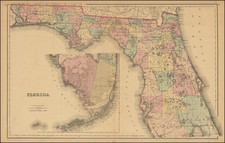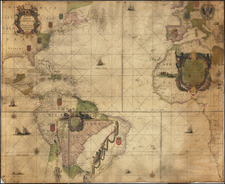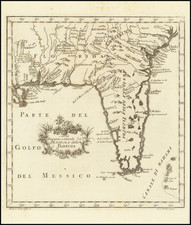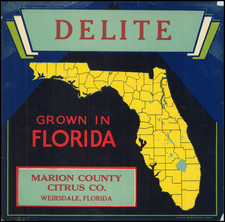Miami Florida on the Eve of the Boom of the 1920s
Fine early map of the City of Miami, approved by Charles W. Murray, Miami City Engineer, printed by The Hefty Company and sold by E.B. Douglas Co of Miami.
This is one of the earliest obtainable city maps of Miami, coming only 22 years after the incorporation of the city in 1918. OCLC locates only a few earlier Sanborn insurance maps and two other maps of the city, published in 1906 and 1914.
The town is laid out on either side of the Miami River, with a number of city blocks subdivided and many others naming larger earlier land owners. The map extends west to just beyond the fork in the River to about 22nd Street
Palm Royal Hotel and Palm Park are shown just north of the Miami River. Constructed by Henry Flagler in 1897, this was Miami's first hotel.
An early baseball park is shown at the west center of the map. This would be Tatum Field, which was the home of the first Miami pro team, the Miami Magicians of the East Florida State League who first took the field in 1912. Tatum Field was first used in 1913, but the grandstand was not completed until 1915.
The US Experimental Grounds are shown just west of Mary Brickell's Amended Plat, which extends north to Brickell Point.
Miami History
In 1891, a Cleveland woman named Julia Tuttle purchased 640 acres on the north bank of the Miami River in present-day downtown Miami. Tuttle tried to persuade railroad magnate Henry Flagler to expand the Florida East Coast Railway, southward to the area, but he initially declined.
Following two devastating freezes in the north of Florida in December 1894 and February 1895, Flagler was again petitioned by Tuttle and this time convinced to extend his railroad to Miami and build a resort hotel.
On April 22, 1895, Flagler wrote Tuttle a long letter recapping her offer of land to him in exchange for extending his railroad to Miami, laying out a city and building a hotel. The terms provided that Tuttle would award Flagler a 100-acre tract of land for the city to grow. Around the same time, Flagler wrote a similar letter to William and Mary Brickell, who had also verbally agreed to contribute land.
While the railroad's extension to Miami remained unannounced in the spring of 1895, rumors of this possibility continued to multiply, fueling real estate activity in the Biscayne Bay area. The news of the railroad's extension was officially announced on June 21, 1895. In late September, the work on the railroad began and settlers began pouring into the promised "freeze proof" lands. On October 24, 1895, the contract agreed upon by Flagler and Tuttle was approved.
On March 3, 1896 Flagler hired John Sewell from West Palm Beach to begin work on the town as more people came into Miami. The first regularly scheduled train arrived on the night of April 15, 1896. On July 28, 1896, the City of Miami, named after the Miami River, was incorporated with 502 voters.
In the early decades of the 20th Century Miami experienced a very rapid growth. In 1900, 1,681 people lived in Miami, Florida; in 1910, there were 5,471 people; and in 1920, there were 29,549 people. Beginning in 1906, canals were made to remove some of the water from those swamp lands west of the city. Miami Beach was developed in 1913 when a two-mile wooden bridge built by John Collins was completed. During the early 1920s, the authorities of Miami allowed gambling and were very lax in regulating prohibition, so thousands of people migrated from the northern United States to the Miami region. This caused the Florida land boom of the 1920s, when many high-rise buildings were built.
Rarity
The map is extremely rare. OCLC locates a single example (Boston Public Library).
This is the first example of the map we have ever seen. We find no other auction or dealer records.












![[Florida / Bahamas] . . . Mosquito Inslet to Key West. . . 1863](https://storage.googleapis.com/raremaps/img/small/75869.jpg)
![[ Charleston, Boston, New York, St. Augustine, Bahamas, etc ] Particular Draughts of some of the Principal Towns and Harbours belonging to the English French and Spanish in America and the West Indies.](https://storage.googleapis.com/raremaps/img/small/102804.jpg)


